
Humayun Abdulali was an Indian ornithologist and biologist who was also a cousin of the "birdman of India", Salim Ali. Like other naturalists of his period, he took an initial interest in shikar (hunting). Unlike Sálim Ali, his main contributions were less field-oriented and based more on bird collections, particularly those at the Bombay Natural History Society where he worked for most of his life.

Bronchocela danieli, also known commonly as Daniel's bloodsucker and Daniel's forest lizard, is a species of lizard in the family Agamidae. The species is endemic to Campbell Bay, Great Nicobar Island, India.
Colonel Richard Henry Beddome was a British military officer and naturalist in India, who became chief conservator of the Madras Forest Department. In the mid-19th century, he extensively surveyed several remote and then-unexplored hill ranges in Sri Lanka and south India, including those in the Eastern Ghats such as Yelandur, Kollegal, Shevaroy Hills, Yelagiri, Nallamala Hills, Visakhapatnam hills, and the Western Ghats such as Nilgiri hills, Anaimalai hills, Agasthyamalai Hills and Kudremukh. He described many species of plants, amphibians, and reptiles from southern India and Sri Lanka, and several species from this region described by others bear his name.
Trimeresurus cantori, commonly known as Cantor's pit viper or Cantor's pitviper, is a species of venomous snake, a pit viper in the Subfamily Crotalinae of the family Viperidae. The species is endemic to the Nicobar Islands of India. It was named after Theodore Edward Cantor (1809-1860), a Danish naturalist serving as a surgeon with the East India Company in Calcutta. No subspecies are recognized as being valid.
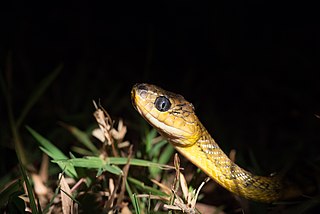
Boiga wallachi, also known commonly as the Nicobar cat snake, is a species of rear-fanged snake in the family Colubridae. The species is endemic to the Nicobar Islands.

Dendrelaphis cyanochloris, commonly known as Wall's bronzeback or the blue bronzeback, is a species of snake found in Southeast Asia.
Dendrelaphis biloreatus is a species of tree snake in the family Colubridae. The species is endemic to Asia.

Dendrelaphis grandoculis, commonly called as the large-eyed bronzeback or southern bronzeback, is a species of Colubrid snake endemic to the Western Ghats of southwestern India.
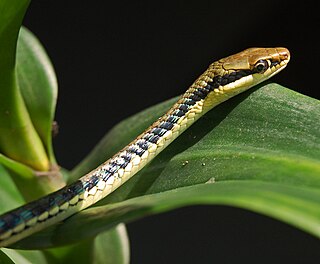
Dendrelaphis pictus is a species of snake found in Southeast Asia and India.

Dendrelaphis tristis is a species of tree-snake found in Sri Lanka, India, Bangladesh, Pakistan, Nepal, Myanmar, and Bhutan.
Oligodon woodmasoni is a species of snake in the family Colubridae. The species is endemic to the Nicobar Islands of India.
Lycodon tiwarii, commonly known as the Andaman wolf snake and Tiwari's wolf snake, is a species of snake in the family Colubridae. The species is native to the Andaman Islands and Nicobar Islands of India.
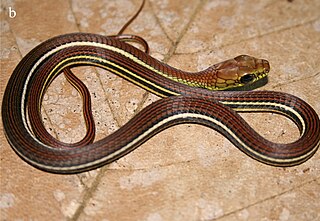
Dendrelaphis caudolineatus is a common species of colubrid snake known commonly as the striped bronzeback or grey bronzeback. It is not venomous and it is the most commonly sold snake as a pet; however, they live longer in the wild.

Dendrelaphis is a genus of colubrid snakes, distributed from Pakistan, India and southern China to Indonesia, Timor-Leste, the Philippines, Australia, New Guinea and the Solomon Islands. There are over forty described species. Asian species are known commonly as bronzebacks, while the Australo-Papuan species are simply called treesnakes. All are non-venomous and entirely harmless to humans.
India is home to a large variety of wildlife. It is a biodiversity hotspot with various ecosystems ranging from the Himalayas in the north to the evergreen rain forests in the south, the sands of the west to the marshy mangroves of the east. India lies within the Indomalayan realm and is the home to about 7.6% of mammal, 14.7% of amphibian, 6% of bird, 6.2% of reptilian, and 6.2% of flowering plant species. India's forests contain about 500 species of mammals and more than 2,000 bird species.

Dendrelaphis punctulatus, also known commonly as the Australian tree snake, the common tree snake, and the green tree snake, is a species of slender, large-eyed, diurnal, non-venomous snake in the family Colubridae. The species is native to many parts of Australia, especially in the northern and eastern coastal areas, and to Papua New Guinea.
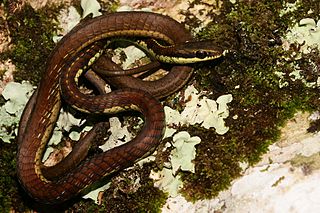
Dendrelaphis schokari, also known as the common bronze-back or Schokar's bronzeback, is a species of non-venomous arboreal snake in the family Colubridae. The species is endemic to Sri Lanka.
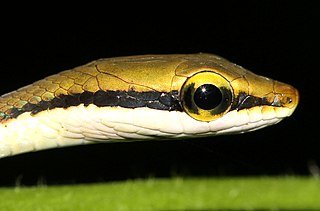
Dendrelaphis girii, Giri's bronzeback tree snake or Giri's bronzeback, is a species of diurnal, arboreal, Colubrid snake endemic to the Western Ghats of southwestern India.
Dendrelaphis oliveri, commonly known as Oliver's bronzeback, is a species of nonvenomous arboreal snake in the family Colubridae. The species is endemic to Sri Lanka. It is considered to be the rarest of the Sri Lankan Dendrelaphis species on account of there being only a single recorded specimen.

Dendrelaphis nigroserratus is a species of snakes belonging to the bronzebacks (Dendrelaphis). It is found only in western and southwestern Thailand and the adjacent southeastern Myanmar. A specimen has been preserved in the British Natural History Museum, London since the early 20th century. Due to its resemblance to Wall's bronzeback, the scientific name was formerly assigned under Dendrelaphis cyanochloris, the species name for Wall's bronzeback. It was formally described as a distinct species in 2012 by Gernot Vogel, Johan Van Rooijen and Sjon Hauser. According to the World Wide Fund for Nature report, it became one of the 367 important new species discovered in the Greater Mekong during 2012 and 2013.













